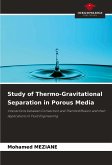Convection is a way of transporting energy by means of potential gradients and fluid movement. Convection is the most important mechanism for transferring energy between a solid surface and a liquid or gas at a different temperature. Energy transfer by convection from a surface whose temperature is higher than that of the surrounding fluid takes place in several stages. The essential characteristics of heat transfer by convection are the transport of energy by molecular movement, known as 'diffusion', and by macroscopic movement of the fluid, known as 'advection'. Heat transfer by convection is referred to as natural or forced convection, depending on the way the fluid flows. If both causes exist simultaneously, without one being negligible compared to the other, the convection is said to be mixed. Mixed convection flow occurs in a cavity with a movable cover with the shear force caused by the movement of the wall and the thrust force produced by the thermal inhomogeneity of the cavity boundaries.
Bitte wählen Sie Ihr Anliegen aus.
Rechnungen
Retourenschein anfordern
Bestellstatus
Storno








